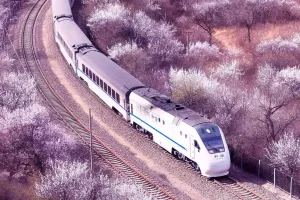In order to facilitate people's transportation, many bridges have come into being; In order to adapt to the development of modern cities and transportation, many well-designed and beautiful overpasses have also come into being. Bridges are also extended to buildings built to make traffic easier to cross mountain streams, undesirable geology or other traffic needs.
Bridges generally consist of superstructures, substructures, bearings and ancillary structures. The superstructure, also known as the bridge span structure, is the main structure that crosses obstacles; The substructure consists of abutments, piers and foundations; A support is a force transfer device provided by the bridge span structure and the support place of the pier or abutment. Bridges are divided according to structural systems, including suspension bridges, arch bridges, rigid bridges, and cable-stayed bridges.
A cable-stayed bridge is a multiple-fold superstatically defined structure. The construction step is to lift the beam with a number of cables from the tower, so that a series of elastic fulcrums are added to the beam span, so as to achieve a significant reduction in the bending moment inside the beam and the purpose of increasing the span.
A suspension bridge is a bridge with a cable or chain bearing component as the main load-bearing member that bears tensile forces. The suspension bridge is composed of suspension cable, rope tower, boom, rope saddle, bridge beam, and anchor pillar. The suspension bridge has the characteristics of saving materials, large spanning ability and beautiful shape. The span of suspension bridges can reach more than 1000 meters, and the maximum span of suspension bridges in the world is close to 2000 meters. Therefore, suspension bridges are known as the "queen of bridges" in the world.
An arch bridge refers to a bridge in which an arch is the main load-bearing member of the structure in the vertical plane. The vertical load is transmitted to the arch through the curved arch, which was first used for flood discharge and navigation under the bridge.
A rigid bridge is a structure that combines a bent supergirder structure with a compressive lower column as a whole. Due to the rigid connection of beams and columns, the entire bridge system is a bent structure and a thrust structure. This kind of bridge body can increase the clearance height under the bridge, and is often used as a cross-line bridge.
Two world-famous bridges are introduced below.
The French Viaduct of Millau is located on the road from Paris to the Mediterranean region, in the city of Millau in southwestern France. The bridge spans the Tarn Valley and is a cable-stayed long bridge. The total length of the bridge is 2.46 kilometers, supported by 7 piers. The Milo Viaduct stretches for several kilometers and is hailed as a classic combination of aesthetics and science.
The Sydney Harbour Bridge spans Port Jackson Bay in Australia and connects the north and south parts of the city of Sydney. It is the largest steel truss arch bridge in the southern hemisphere, with a total length of 1149 meters, a height of 134 meters and a width of 49 meters. It was built at the time with the largest span arch bridge in the world. The bridge is like a rainbow hanging in the blue sky, and after nightfall, the bridge is illuminated, like a brilliant pearl embedded in the starry Sydney city.


